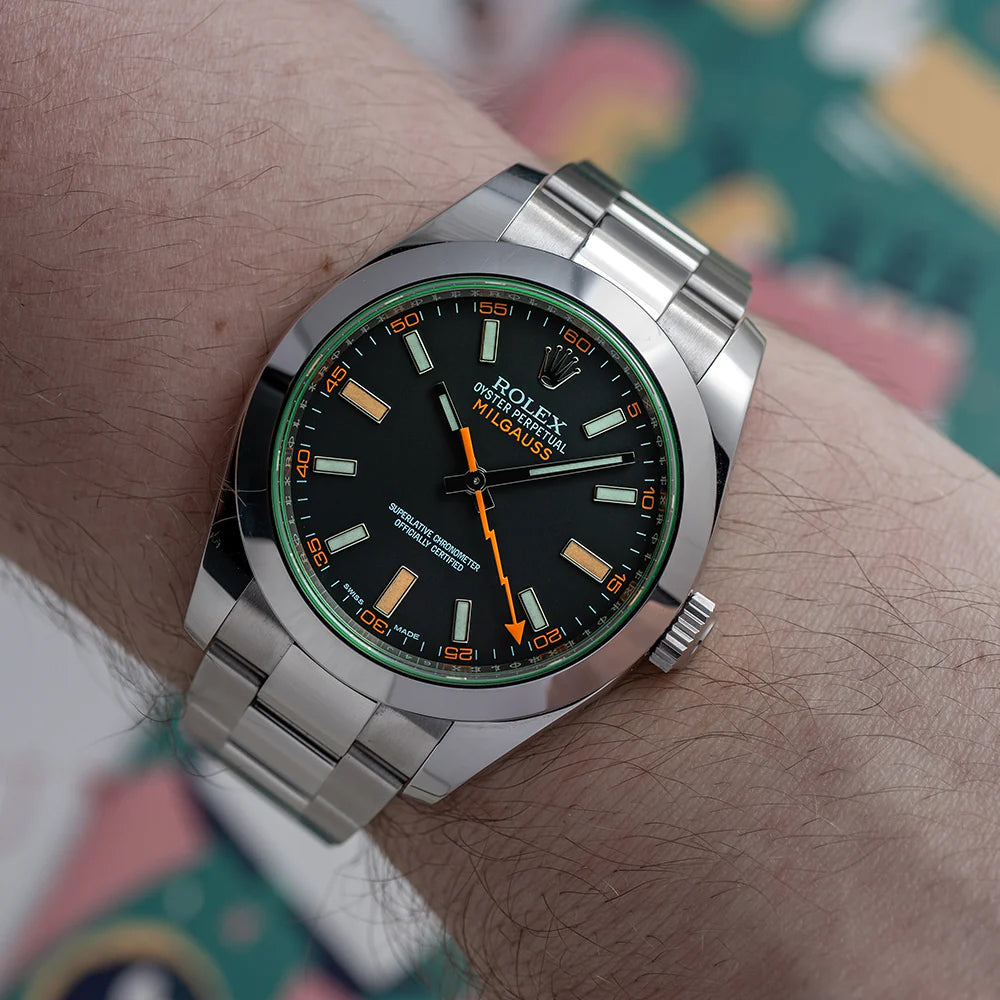Today, technology permeates every aspect of our lives. But did you know technology can also threaten the integrity of mechanical watches?
That’s where anti-magnetic watches come in. These types of watches are specifically designed to counteract these effects.
Let’s take a closer look at how anti-magnetic watches work, and why you’d want to protect your watch from magnetism in the first place.
The Rise of the Anti-Magnetic Watch
 Citizen Pro Master Ray Mears on Original Vintage Highley Genuine Leather Watch Strap - Credit WatchGecko
Citizen Pro Master Ray Mears on Original Vintage Highley Genuine Leather Watch Strap - Credit WatchGecko
- Regular price
- $127.00 CAD
- Regular price
-
- Sale price
- $127.00 CAD
- Unit price
- per

- Regular price
- $127.00 CAD
- Regular price
-
- Sale price
- $127.00 CAD
- Unit price
- per

- Regular price
- $127.00 CAD
- Regular price
-
- Sale price
- $127.00 CAD
- Unit price
- per

The story of the anti-magnetic watch begins in the late 19th and early 20th centuries, a time of rapid technological and industrial advancement. In this era, scientists and engineers were increasingly encountering strong magnetic fields generated by new technologies like electrical machinery, power lines, and even early medical equipment. These fields posed a significant threat to the delicate inner workings of mechanical watches, causing them to lose time or malfunction entirely.
Recognizing the vulnerability, watchmakers embarked on a quest to develop timepieces that could resist the influence of magnetism. Pioneering brands like Vacheron Constantin, IWC, and Tissot (with their Tissot Antimagnetique) were among the first to experiment with non-magnetic materials for watch components, particularly focusing on the balance spring, a critical element for accurate timekeeping.
 Citizen Pro Master Ray Mears - Credit WatchGecko
Citizen Pro Master Ray Mears - Credit WatchGecko
Early adopters of anti-magnetic watches included professionals who frequently encountered strong magnetic fields. Aviators, engineers, and scientists (especially those working at places like CERN) who relied on precise timekeeping in potentially magnetized environments found these specialized watches invaluable.
Over time, as technology continued to evolve and magnetic fields became more ubiquitous, the appeal of anti-magnetic watches broadened, eventually becoming a desirable feature for a wider range of watch enthusiasts and professionals.
What Does It Mean if a Watch is Anti-Magnetic?
An anti-magnetic watch is engineered to run unaffected by magnetic fields. It uses various materials and designs to shield its movement. We’ll take a look at these specific materials and strategies in the next section, but it’s worth asking here why you’d want to protect your watch from magnets in the first place.
Unfortunately, magnetism can adversely affect the accuracy of traditional watch movements. If a magnetic field is strong enough, it can cause your watch to run too fast or too slow.
This can happen when a watch's metallic components, particularly those in the movement, are exposed to a magnetic field strong enough to realign the atoms in the metal. This realignment affects the balance wheel and the hairspring, the heart of your watch's timekeeping mechanism, causing it to speed up or slow down dramatically.
And we’re not talking about the magnetic field of a data center or supercomputer. Everyday items like smartphones, tablets, and even induction stoves generate magnetic fields strong enough to disrupt a watch's movement.
Luckily, certain technologies in anti-magnetic watches can protect your watches from these forces.




2019 Rolex Milgauss Black Dial 116400GV - Credit Kibble Watches
How Do Anti-Magnetic Watches Work?
1. Special Materials
Modern anti-magnetic watches often incorporate silicon in their escapements and balance springs.
Silicon, being non-ferrous, does not react to magnetism.
Other non-magnetic materials like titanium and ceramic are also used for parts of the movement and the watch case, further reducing magnetic susceptibility.
2. Innovative Design Features
Some timepieces feature a soft iron inner case that envelops the movement, acting as a Faraday cage to reroute magnetic fields away from the sensitive parts of the watch.
Alternatively, brands like Rolex and Omega have developed movements that are inherently anti-magnetic, eliminating the need for additional protective cases.
The Rolex Milgauss and the Omega Seamaster Aqua Terra stand out for their anti-magnetic properties.
The Rolex Milgauss, for instance, was specifically designed for scientists exposed to high magnetic fields, capable of withstanding up to 1,000 gauss.
Omega's approach involves constructing the movement from non-ferrous materials, offering resistance beyond 15,000 gauss.
IWC is another brand that was early to the anti-magnetic scene, producing anti-magnetic watch movements as early as 1888. Their Ingenieur 666 was popular in the 1950s as an anti-magnetic watch designed for professionals who were increasingly exposed to magnetic fields – like doctors, technicians, pilots, chemists, physicists, etc.
3. Testing and Certification of Anti-Magnetic Watches
 Omega Seamaster Aqua Terra - Credit WatchGecko
Omega Seamaster Aqua Terra - Credit WatchGecko
Anti-magnetic watches are tested and certified. The ISO 764 standard dictates that a watch must resist direct current magnetic fields of .48 gauss and show minimal deviation in timekeeping to be considered anti-magnetic.
Testing procedures often involve exposing the watch to increasingly strong magnetic fields to ensure compliance.
Demagnetizing a watch is a straightforward process that can restore its accuracy if it has become magnetized. There are a few methods to demagnetize a watch, ranging from professional services to DIY solutions, each effective in reversing the effects of magnetization.
How Do You Demagnetize a Watch?
If you don’t have an anti-magnetic watch and think that your watch may have become magnetized, demagnetizing it is always an option. There are a few ways to do so.
Professional Demagnetization
 Omega Seamaster Aqua Terra - Credit WatchGecko
Omega Seamaster Aqua Terra - Credit WatchGecko
The most reliable way to demagnetize a watch is to take it to a professional watchmaker or a service center. They use a specialized tool called a demagnetizer or degausser, designed specifically for this purpose.
The process involves passing the watch over or placing it within a coil connected to the demagnetizer, which generates a controlled electromagnetic field. This field neutralizes the magnetic charges within the watch's components, effectively demagnetizing it.
Professional demagnetization ensures that the process is done safely and effectively, without risking further damage to the watch.
DIY Methods
 Omega Seamaster Aqua Terra - Credit WatchGecko
Omega Seamaster Aqua Terra - Credit WatchGecko
For those who prefer a more hands-on approach or when professional services are not readily available, there are DIY methods to demagnetize a watch. One common tool is a handheld demagnetizer, available for purchase online.
The procedure involves turning on the demagnetizer, slowly moving the watch back and forth above it for a few seconds, and then moving the watch away before turning the demagnetizer off. It's crucial to follow the instructions carefully to avoid inadvertently magnetizing the watch further.
Another method involves using certain apps available on smartphones that can generate a demagnetizing field. While this method may offer a temporary fix, its effectiveness is not as reliable as using a dedicated demagnetizer, and it's generally recommended as a last resort.
Precautions
Regardless of the method chosen, it's important to exercise caution. Improper use of a demagnetizer can cause further magnetization or damage the watch. Additionally, if the watch has other underlying issues, demagnetizing it may not resolve its timekeeping inaccuracies.
In most cases, a professional watch service is your best option. They can diagnose and address any mechanical problems.
Does Working at the Poles Require an Anti-Magnetic Watch?
Lastly, it’s worth addressing a common misconception. There’s an urban myth that working at the Earth's North or South Poles requires an anti-magnetic watch.
While these poles do possess unique magnetic properties, the strength of the Earth's magnetic field at these locations is actually not a significant threat to the timekeeping of standard mechanical watches.
Here's why the myth doesn't hold water:
- Earth's Magnetic Field Strength: The Earth's magnetic field strength at the poles is around 0.6 gauss (G), which falls well below the threshold that can disrupt most mechanical watches. As noted earlier, the ISO 764 standard for anti-magnetic watches requires them to withstand fields of at least 0.48 G, and many modern watches can handle even stronger fields.
- Real-World Magnetic Sources: The primary concern for watch magnetism comes from man-made sources like power lines, medical equipment, and even some everyday objects like speakers and magnetic clasps. These sources typically generate much stronger magnetic fields than the Earth's natural field, even at the poles.
So while anti-magnetic watches offer certain advantages and cater to specific professions, working at the North or South Pole wouldn't necessitate one solely due to the Earth's magnetic field strength.
That said, it doesn’t hurt, either! Especially if your work involves encountering man-made magnetic fields in those regions. An anti-magnetic watch could still be a valuable choice.
Final Thoughts
We’re continuing to surround ourselves with more electronic devices, so the relevance of anti-magnetic watches is undeniable. They offer peace of mind to those who frequently encounter magnetic fields in their daily lives or occupations.
But you can also prevent magnetization by keeping your watch away from technological devices. If you do suspect it’s become magnetized, you can take it to a watch service to have it demagnetized.

















